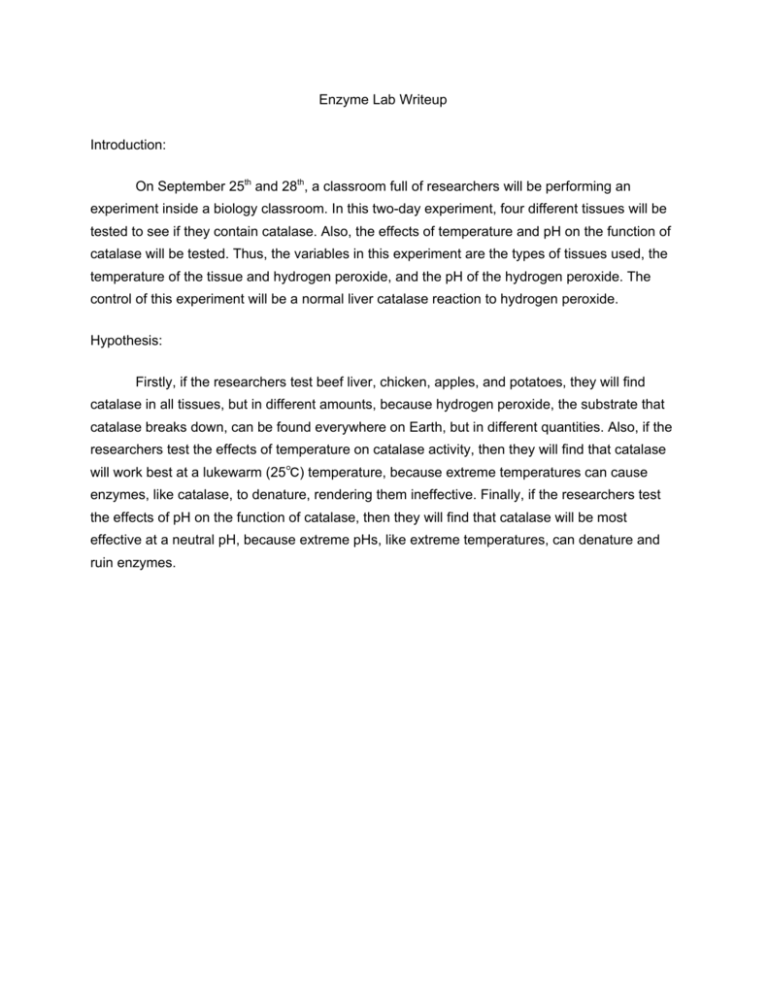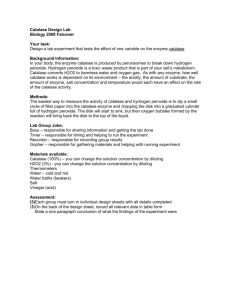Enzyme Lab Writeup Introduction: On September 25th and 28th
advertisement

Enzyme Lab Writeup Introduction: th th On September 25 and 28 , a classroom full of researchers will be performing an experiment inside a biology classroom. In this two­day experiment, four different tissues will be tested to see if they contain catalase. Also, the effects of temperature and pH on the function of catalase will be tested. Thus, the variables in this experiment are the types of tissues used, the temperature of the tissue and hydrogen peroxide, and the pH of the hydrogen peroxide. The control of this experiment will be a normal liver catalase reaction to hydrogen peroxide. Hypothesis: Firstly, if the researchers test beef liver, chicken, apples, and potatoes, they will find catalase in all tissues, but in different amounts, because hydrogen peroxide, the substrate that catalase breaks down, can be found everywhere on Earth, but in different quantities. Also, if the researchers test the effects of temperature on catalase activity, then they will find that catalase will work best at a lukewarm (25℃) temperature, because extreme temperatures can cause enzymes, like catalase, to denature, rendering them ineffective. Finally, if the researchers test the effects of pH on the function of catalase, then they will find that catalase will be most effective at a neutral pH, because extreme pHs, like extreme temperatures, can denature and ruin enzymes. The tissue with the highest reaction rate is liver at 4, and the lowest is apple at 0.42. Both times H O were tested, it had a reaction rate of 4, and H O had no reaction. 2 2 2 50℃ had the highest reaction rate at 4.16, and 89℃ had the lowest reaction rate at 2.28. PH 5 had the highest reaction rate at 3.64, and pH 3 had the lowest reaction rate at 2.21. Catalase is an enzyme that breaks down the molecule H O into the harmless molecules 2 2 H O and O . This was tested by the researchers in their experiments. They poured H O onto 2 2 2 2 liver, which contains catalase, and found a reaction. They then poured H O onto the liver, and 2 found no reaction. This is because catalase is an enzyme, which are very specific in the molecules they break down. Catalase only breaks down H O , which is why there was a 2 2 reaction to it, and not a reaction to the H O. 2 The researchers also performed an experiment to find which tissues contained catalase, and which didn't. The result of this experiment is that catalase is found in liver, potato, chicken, and apple, but in different amounts. This was measured by the reaction rates of each tissue and H O . The liver had the highest reaction rate, followed by potato and chicken, which had less 2 2 than half the reaction rate of the liver, and finally apple, which had nearly no reaction to the H O . Therefore, liver has the most abundant supply of catalase, potato and chicken has less 2 2 than half as much as liver, and apple has nearly no catalase in it. Another experiment that was performed revolved around the denaturing of the catalase. The liver, and therefore the catalase, was subjected to the temperatures of 4℃, 25℃, 35℃, and 89℃, then was measured by the reaction of it to H O . The livers with the least amount reaction 2 2 were the livers that were subjected to the extreme temperatures, 4℃ and 89℃. Also, different livers were subjected to the H O with pHs of 3, 5, 7, 9, and 11 pH, then measured, as in the 2 2 temperature experiment. As with the livers with different temperatures, the least amount of reaction happened in the livers with extreme pHs, pH 3 and 9. Interestingly, however, the reaction rate of pH 11 was the second highest measured, although this is most likely a measurement error. The reason the extreme temperatures and pHs had the least amount of reaction is due to the denaturing of the catalase. The temperature and pH deform the enzyme, making the H O no longer “fit” it, rendering the catalase ineffective. 2 2 This experiment has a connection to the real world. Understanding the function and limitations of catalase is important in health­related undertakings. Because enzymes such as catalase are used by animal tissues to break down harmful substances, it can be useful to understand how they work in order to diagnose certain illnesses. Also, the effects of extreme pH and temperature on the function of catalase is very important to many health­related tasks, and knowledge of them is also helpful in diagnosing some illnesses.






